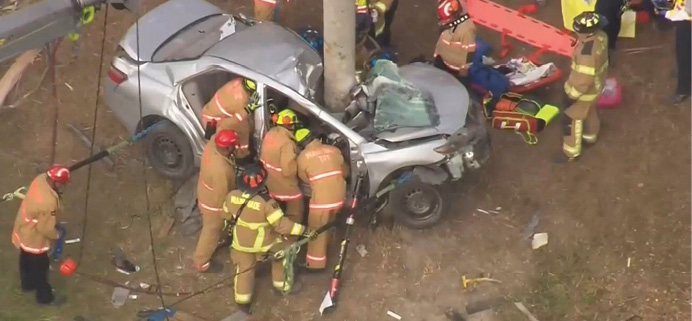
By Jairo Rodriguez
One of Isaac Newton’s laws of physics states that for every action there is an equal and opposite reaction. Physics is a factor in almost every extrication operation because powerful forces applied to a vehicle to cut, pry, and pull it away from a trapped patient can be transferred to other portions of the vehicle and impinge on the patient, causing additional injuries. Physics was definitely a factor when Miami-Dade (FL) Fire Rescue (MDFR) firefighters worked to free a driver who was severely trapped in the wreckage of his vehicle (photo 1). The driver lost control of his vehicle, which left the roadway, skidded down into a storm-water swale and up the other side, and struck a tree. The vehicle was wrapped around the tree on the driver’s side, resulting in the driver’s being severely injured and terribly trapped. Because of the downward slope of the swale, the wheels on the passenger side of the vehicle were suspended in the air, making the vehicle extremely unstable.
Continuous Command and Medical Monitoring
On arrival, first-arriving companies established command, conducted a scene size-up, and performed initial stabilization and fire control measures by stretching a 1¾-inch hoseline and positioning large dry chemical extinguishers near the accident vehicle. Command designated a medical group, which made patient contact and initiated medical treatment by positioning a technical rescue paramedic firefighter inside the vehicle with the patient.
![Miami-Dade (FL) Fire Rescue firefighters work to free the severely trapped driver. [Photos courtesy of Miami-Dade (FL) Fire Rescue.]](/wp-content/uploads/2019/09/1909FE_Rodriquez-p01.jpg)
(1) Miami-Dade (FL) Fire Rescue firefighters work to free the severely trapped driver. [Photos courtesy of Miami-Dade (FL) Fire Rescue.]
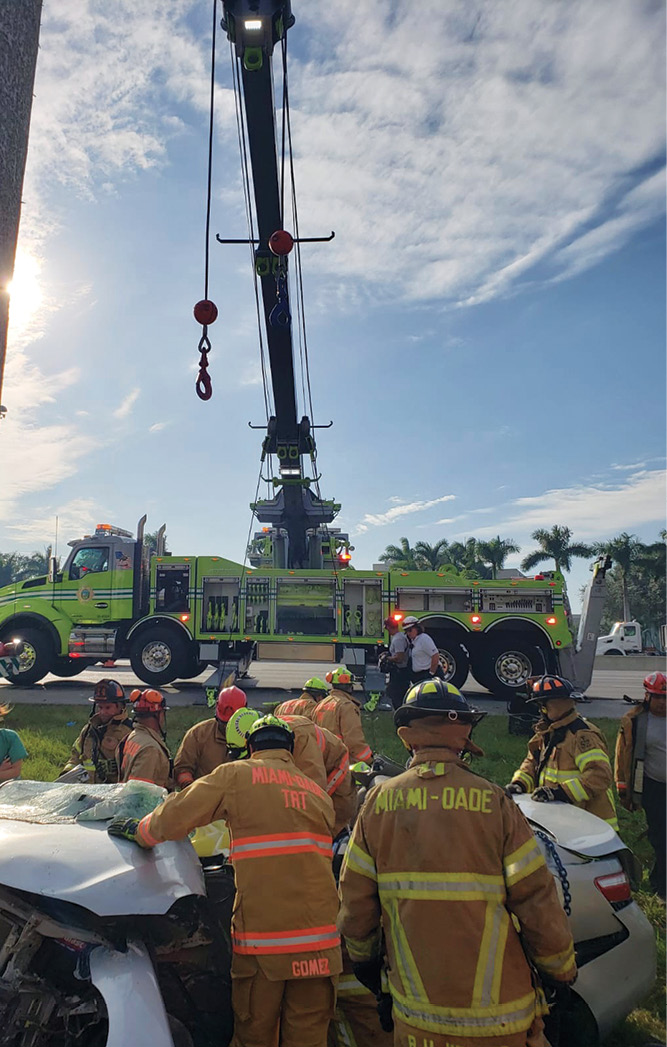
(2) Miami-Dade (FL) Fire Rescue’s heavy rescue rotator “The Heavy” on the scene of its first save.
When a patient is trapped and seriously injured, the patient’s condition drives the extrication operation, influencing the techniques used, monitoring for and adapting to any adverse effects on the patient, and determining the urgency and appropriate speed of the operation. Additionally, an extended and difficult extrication operation necessitates strong leadership because initial actions are likely to fail. A strong leader constantly evaluates the effectiveness of the extrication techniques and stops personnel from doing something when it isn’t working.
The medic inside the vehicle was a critical component to the success of this operation. She continuously monitored the patient’s condition and vital signs, administered advanced life support medical care, and provided comfort and reassurance throughout the operation.
Command also established an extrication group, which was initially assigned to the area’s technical rescue unit. MDFR has three technical rescue fire companies equipped with various technical rescue equipment strategically placed throughout the department’s response area. These companies begin and often successfully complete rescue operations before the department’s heavy rescue (HR) squad, which is a countywide resource, arrives. But, not this time.
Assessment and Setup
On being advised of the patient’s condition and the extent of the entrapment, command requested that the department’s HR squad company respond and bring “Heavy-1,” MDFR’s 50/60-ton heavy rescue rotator (HV1) (photo 2), which is kept at quarters. Unlike conventional wreckers, which operate only from the rear, Heavy-1, like a crane, has a rotating boom (see “Alliances with Local Towing and Recovery Professionals”). Additionally, because of the severe entrapment of the patient’s legs, trauma surgeons were requested should a field amputation be needed. It is extremely important that fire officers supervising an extrication operation request resources proactively and not exhaust all assets on the scene before formulating and implementing a Plan B. At this entrapment, amputating the patient’s legs would definitely be a last resort.
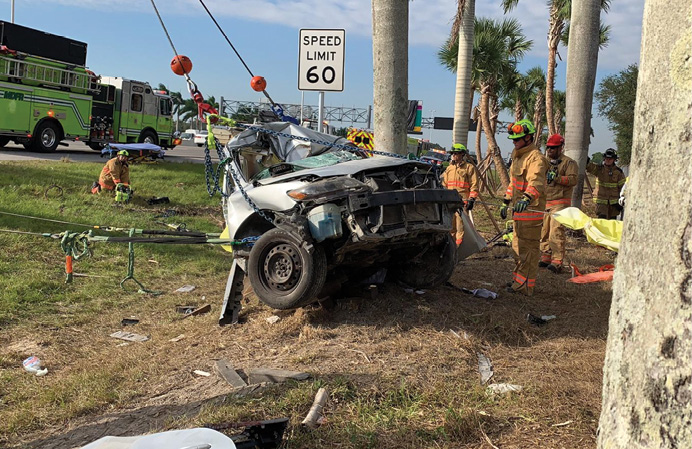
(3) The rotator had to operate from a less than ideal position, causing the vehicle to be out of the reach of the fully extended rotator boom. The wire rope deploying from the tip of the boom had to come in at an angle, causing an undesired pendulum effect.
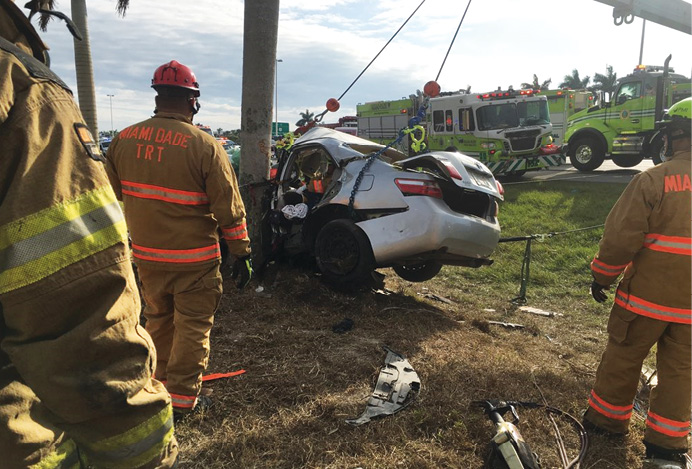
(4) The rescuer is guiding and monitoring a control line or tie-back (with the yellow cover) opposite the points from which the vehicle is being pulled.
Rescuers managed to free one of the patient’s legs, but the other leg remained wrapped and wedged around the tree. The paramedic inside the vehicle continued to hold the victim’s torso and head, which were hanging outside the vehicle. The patient literally had his torso and head up against one side of the tree and his legs on the other side of the tree. The vehicle was so tightly wrapped around the tree in the area of the patient’s legs that it was difficult to distinguish between flesh and metal. It became evident that rescuers would have to unwrap the vehicle along with the patient’s leg from around the tree. This would not be easy.
Just pulling the vehicle from the tree without considering the physics involved could do more harm than good: The action of pulling the vehicle from the passenger side would most likely result in a reaction on the driver’s side, further injuring the patient. Preventing any unintended movement would necessitate an extensive rigging and winching operation.
It was a long run for the HR squad and the Heavy-1 rescue rotator because the crew was training at the other end of the county. Therefore, the HR Squad officer communicated with command while en route, advising how the rotator would be positioned and deployed, based on information the officer had previously been given. This enabled the crews on scene to clear the area for the rotator to set up its stabilization outriggers, extend and rotate its boom, and deploy the winches necessary to remove the vehicle from the tree without delay.
The rotator arrived. After it was in position, the crews gathered and formulated an incident action plan for rigging, pulling, and lifting the vehicle. As mentioned, because of the swale’s uneven ground, the vehicle’s wheels were in the air and the passenger side could easily slide down the slope of the swale while the driver’s side pivoted upward with the patient’s leg becoming the fulcrum, which would increase the potential for a field amputation.
The Rotator Operation
To prevent further injury to the patient, it was critical that the vehicle be pulled directly perpendicular from the tree while keeping the vehicle leveled from front to back and from side to side. The crew configured an adjustable rigging system that individually controlled the movement of the vehicle at four points. The success of this procedure necessitated close communication among the paramedic in the vehicle, spotters, and the rotator operator. The operator had to simultaneously control the action of four winches, each of which had a direct effect on the other. The operator basically had a four-point balancing act; the slightest movement in the wrong direction would significantly harm the patient or the paramedic/rescuer inside the vehicle.
Alliances with Towing and Recovery Professionals
Another challenge was that the swale made it necessary to operate the rotator from a less than an ideal position (photo 3), which resulted in the vehicle’s being out of the reach of the rotator’s boom when fully extended. Consequently, the wire rope deploying from the tip of the boom would come in at an angle and cause the vehicle to swing and move downward toward the middle of the swale. Rescuers devised a way to control this pendulum effect: They created a control line or a tie-back opposite the points from which the vehicle was being pulled (photo 4).
ALSO
The First 10 Minutes: A Best Practices Approach to Motor Vehicle Crash Response
To overcome the challenges and address all the concerns, the four-winch operation was performed with the two main winches coming off the tip of the rotator’s boom to capture the vehicle from the top side and control it from side to side and from front to back to keep it as level as possible while being pulled off the tree by the rotator’s other two winches (auxiliary winches) that deploy mid-boom (photo 5). The wire ropes from the two auxiliary winches, located mid-boom, ran straight down to snatch blocks (pulleys) attached to the rotator’s side outriggers. The snatch blocks provided the change of direction necessary to vector the tension of the wire ropes horizontally to pull the vehicle away from the tree while the two main winches from the tip of the boom were tensioned vertically to keep the vehicle level.

(5) The wire ropes from all five winches are being tensioned in unison—two winches maintaining the levelness of the vehicle (tensioned vertically); two winches pulling the vehicle away from the tree (tensioned horizontally); and one winch, on the driver’s side of the vehicle, used as the control line (with yellow cover), positioned opposite the rotator. Note the spotters at all the critical points/areas of the operation.
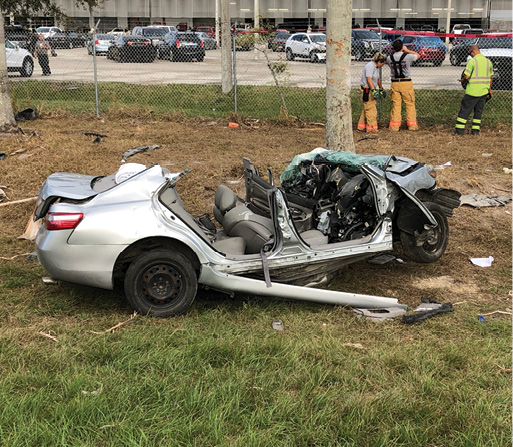
(6) The area where another MDFR apparatus was positioned to employ a fifth winch to establish the control or the tie-back line, off the highway opposite of where the rotator was positioned. Crew members are securing the fence that was cut to access that parking lot.

(7) Personnel clear the vehicle as all winches operate in unison to remove the vehicle from the tree in an extremely smooth and controlled manner.
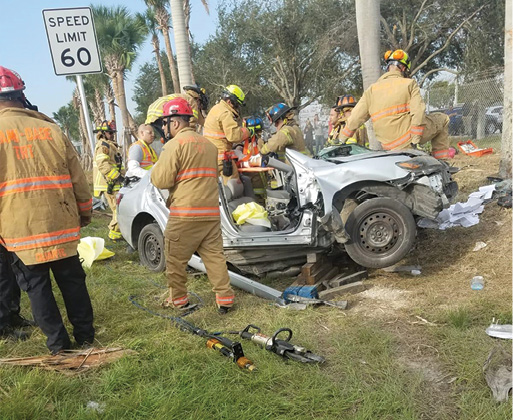
(8) Rescuers package and remove the patient from the vehicle after the patient’s lower extremity was released from the wreckage, avoiding a field amputation.
A control line employed a fifth winch from another MDFR apparatus that was parked off the highway opposite of where the rotator was positioned. The apparatus was directed off the highway to the parking lot directly adjacent to the incident site. Cars had to be cleared from the lot and a chain link fence had to be cut before the control line could be established between the apparatus winch and the accident vehicle (photo 6). Once that was accomplished, the wire ropes from all five winches were tensioned in unison.
Except for the medic, who remained in the vehicle throughout the duration of the operation, all personnel were cleared from the area while the winches were in operation (photo 7). With great coordination and excellent communication by everyone involved, the vehicle was surgically removed from the tree in an extremely smooth and controlled manner. Once the vehicle was removed and settled down at the bottom of the swale, it was cribbed and extrication was again initiated. The crews removed the roof and the surrounding metal from the trapped extremity. As soon as the victim’s leg was released from the impingement point, the medical group removed the patient from the vehicle. The patient was further immobilized and packaged for transport to the closest trauma center (photo 8). The amputation was avoided.
JAIRO RODRIGUEZ is a 26-year veteran of the fire service and a lieutenant on Miami-Dade Fire Rescue’s Heavy Rescue Squad Company. He developed the department’s heavy rescue rotator training program. He is a rescue team manager for FEMA’s Florida Task Force 1 Urban Search and Rescue Team and has been deployed to various major catastrophes nationally and internationally; he is a FEMA structural collapse instructor. He has instructed in firefighting and technical rescue training programs in South American, Central American, and European countries. Rodriguez is certified as a paramedic, marine/shipboard firefighter, rescue scuba diver, and technical rescue technician.

